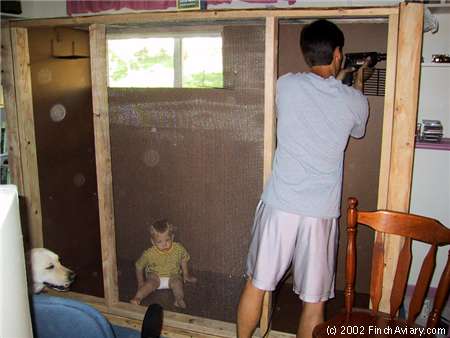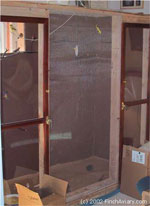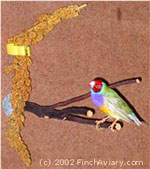The
Temporary Aviary

Birds
on a Wire! The plastic clothesline
was the most popular perch in the temporary aviary.
|
|

Tom
installs the perches in the temporary aviary. Zach
thinks he might like to move in.
|
|
 The
doors from the original aviary were installed on
the temporary aviary and the birds moved in.
The
doors from the original aviary were installed on
the temporary aviary and the birds moved in. |
|

Extra
manzanita perches were used in the temporary aviary. |
|
While
the new aviary was being built, the birds had to be moved from
the old aviary. This was true for a number of reasons. First,
we were having new carpeting installed in the Living Room, where
the aviary resides. Carpet fumes can be hazardous for the birds.
We were also taking the opportunity to touch up on some painting
and staining in the room - again putting the birds at risk for
exposure to hazardous fumes. Finally, because the new aviary
was going to be built where the old aviary was located and the
old aviary was too big to be moved, the birds would have to
be relocated and the existing aviary destroyed before the new
aviary could be built. Due to its size, the new aviary had to
be built in place..
One
option would have been cages. This was not the optimal choice,
however. First, cages are expensive and we would need to buy
several additional cages to house all of the birds. Second,
the birds had become accustomed to having lots of space and
it would be difficult to deprive them of this, even for a few
weeks. Third, it is more time consuming to maintain a number
of cages than to maintain a single aviary. Finally, the button
quail are unsuitable for cage life - needing height to prevent
them from injuring themselves if they become startled and jump
up.
So
instead, we decided to build a quick and dirty temporary aviary.
The temporary aviary was constructed from 2x4s, hardware cloth,
and cheap particle board. The doors from the existing aviary
were attached to the temporary aviary for convenience. I used
spare manzanita branch perches and metal bird sundecks for perches,
and added a plastic clothesline swing (which, to my surprise,
turned out to be the favored perching spot for all birds). The
total cost to build the temporary aviary was somewhere around
100 dollars.
Aside
from being unsightly, the temporary aviary would be an unsuitable
permanent home for the birds. The particle board walls and floor
are not very strong and could become damaged by water exposure
over time (the floor was lined with a peelable shelf liner for
a little extra protection). The exposed wood of the 2x4s is
difficult to clean. And the particle board was a dark color,
making the aviary a little too dark for my liking and also making
it difficult to view the birds. The hardware cloth was not painted
black and so visibility through the mesh is poor. Nonetheless,
it made a suitable home for a short period and the birds adjusted
quite nicely.
Click
Previous to return to the Aviary Plans | Click Next to read
about the Structural Frame
PREVIOUS
 |
|  NEXT
NEXT
 TOP
TOP



